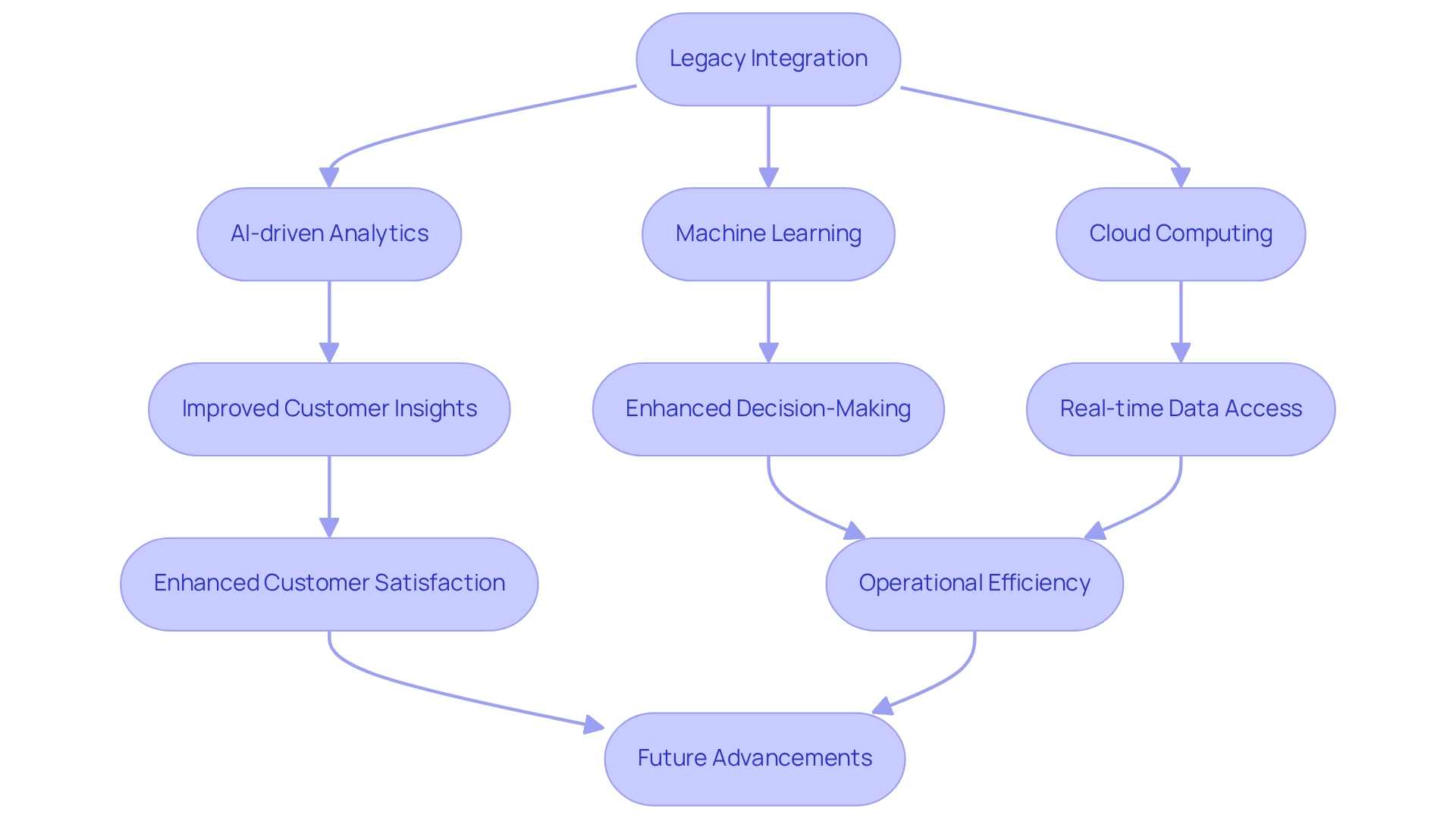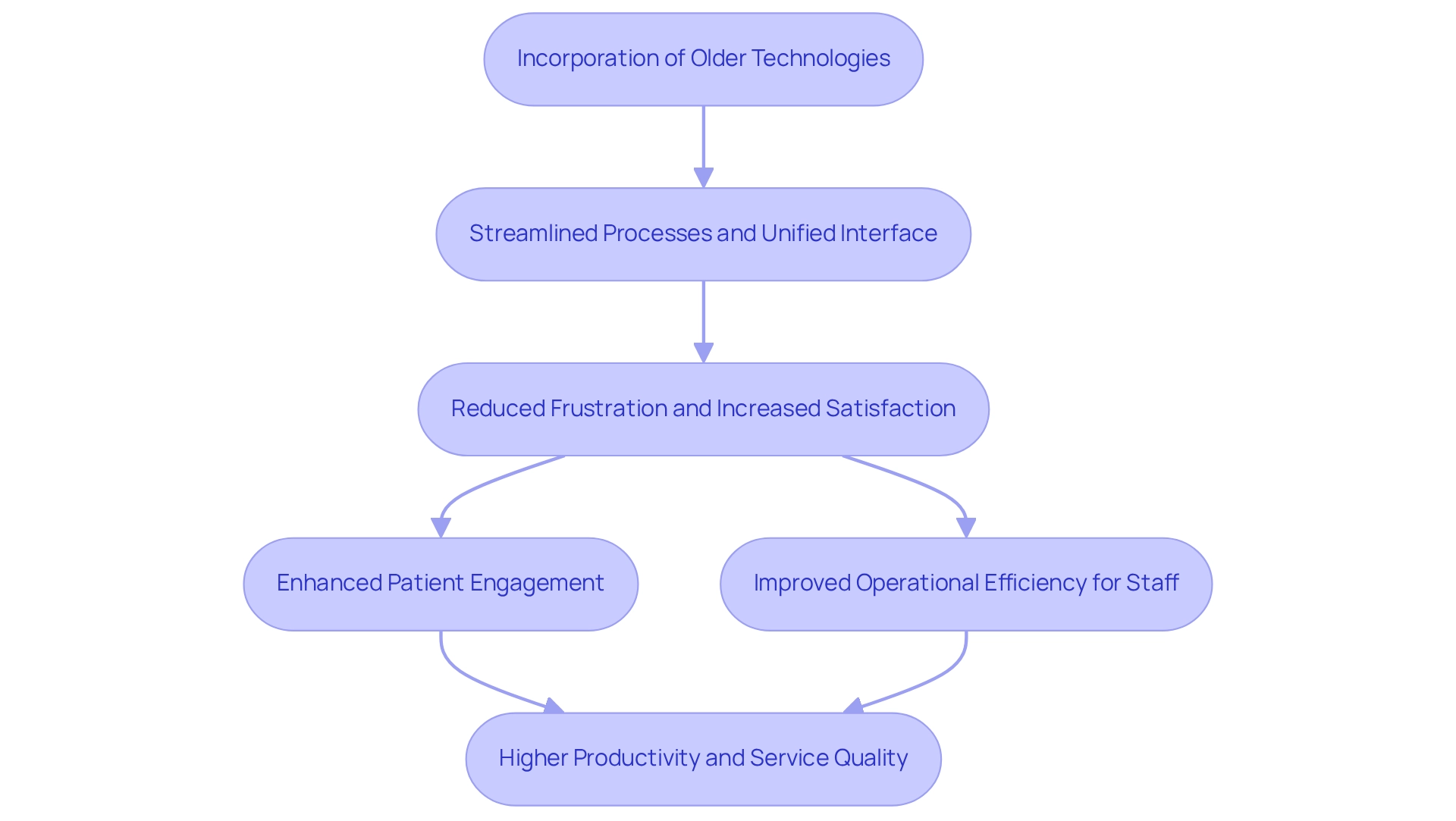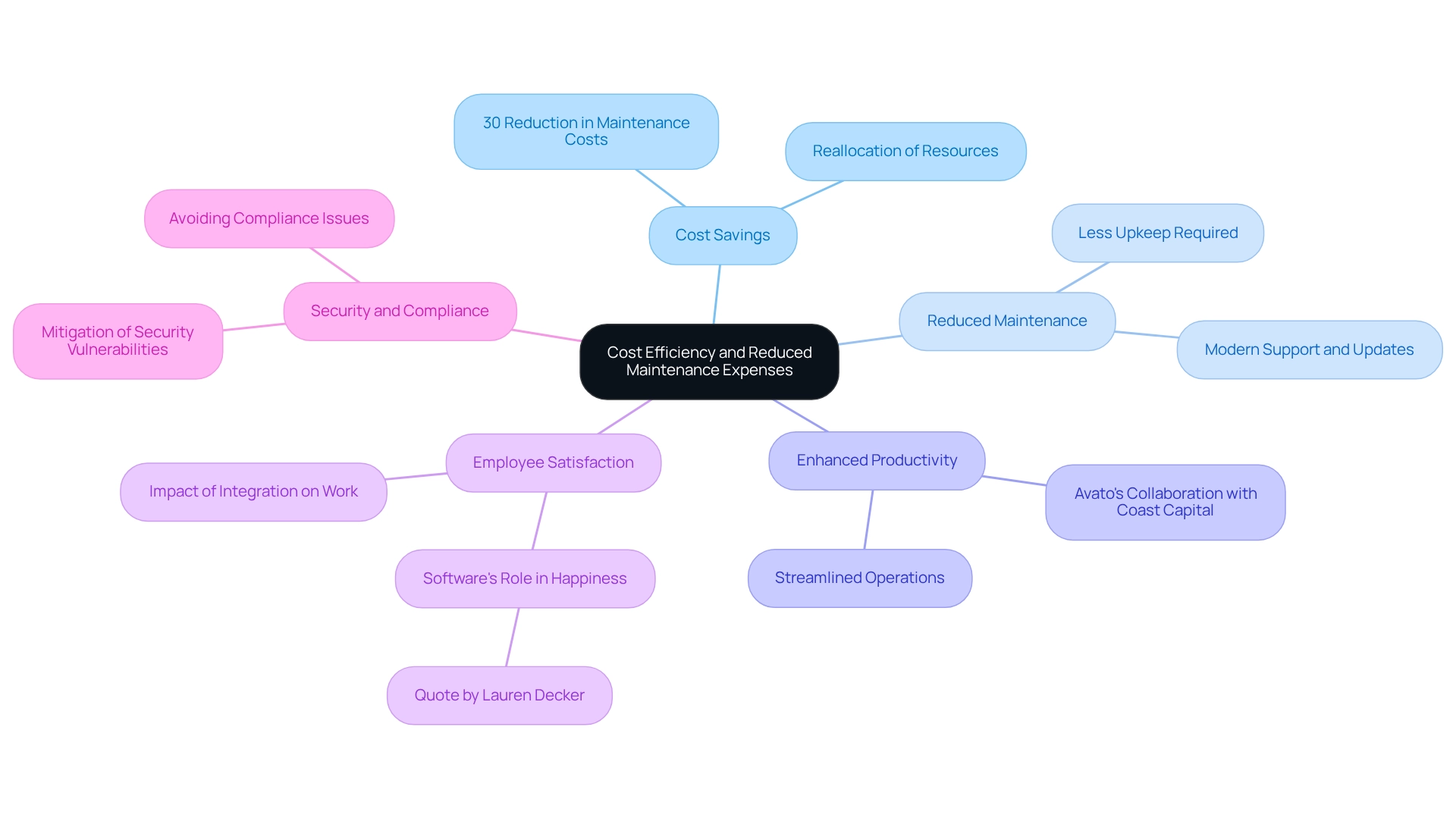Overview
Legacy integration offers significant advantages for modern businesses, including enhanced operational efficiency, improved decision-making through real-time data access, and considerable cost savings. By connecting outdated systems with modern technologies, organizations can streamline processes, automate tasks, and reduce maintenance expenses. This integration ultimately positions businesses for greater agility and competitiveness in their respective markets.
Furthermore, consider the challenges your organization faces with legacy systems. Are inefficiencies hindering your growth? By embracing legacy integration, you can transform these challenges into opportunities. Imagine a scenario where your teams can access critical data instantly, enabling informed decisions that drive success.
In addition, the cost savings realized through reduced maintenance and improved operational efficiencies can be reinvested into innovation and growth strategies. As a result, organizations that prioritize legacy integration not only enhance their current capabilities but also future-proof their operations against evolving market demands.
The time to act is now. Explore how legacy integration can revolutionize your business processes and position you ahead of the competition.
Introduction
In today’s digital landscape, organizations face the formidable challenge of modernizing operations while still depending on legacy systems that have long supported their infrastructure. Legacy integration stands out as a vital solution, effectively bridging the divide between outdated technologies and contemporary applications. This strategic approach not only enhances operational efficiency and drives cost savings but also unlocks advanced functionalities capable of transforming business processes.
As companies navigate the complexities of digital transformation, grasping the nuances of legacy integration becomes crucial for unlocking new capabilities and sustaining a competitive edge in an ever-evolving market. With insights from industry experts and real-world examples, this article explores the myriad benefits of legacy integration, demonstrating how organizations can thrive by leveraging existing assets while embracing innovation.
Understanding Legacy Integration: A Foundation for Modernization
Connecting older platforms and applications with newer technologies is a crucial endeavor for companies dependent on outdated technology as they strive to modernize their operations. By 2025, a significant proportion of organizations will still be utilizing outdated systems, underscoring the urgent need for effective unification strategies. Mastering the intricacies of traditional system connections allows companies to navigate the complexities of digital transformation adeptly, maximizing the value of existing assets while seamlessly adopting innovative technologies.
The benefits of legacy integration are extensive, particularly in the context of modernization. It empowers organizations to enhance operational efficiency, reduce costs, and improve service delivery. For example, a survey revealed that manufacturers account for 47% of companies seeking to purchase ERP software, highlighting the critical role of integrated systems in streamlining operations across diverse sectors.
This relevance is further emphasized by Deutsche Bank’s announcement of a first-half 2024 profit before tax of €2.4 billion, showcasing the financial impact of successful historical integration within the banking sector.
However, the journey toward digital transformation is not without its challenges. Many organizations struggle with outdated technology that can impede progress. As Michael J. Hsu, Acting Comptroller of the Currency, noted, some banks may ‘feel like hostages’ to their outdated systems, accentuating the urgency for effective unification solutions.
Expert opinions consistently affirm the significance of established systems in propelling digital transformation. By facilitating legacy integration between traditional and modern frameworks, companies can not only protect their investments but also enhance their flexibility in responding to market demands. This adaptability is vital for sustaining a competitive edge in an ever-evolving landscape.
Avato’s dedicated hybrid connection platform plays a pivotal role in assisting businesses with legacy integration, enabling them to adapt to changing demands and reinforcing the advantages of traditional connectivity. The platform features real-time monitoring and alerts on system performance, essential for ensuring operational efficiency and responsiveness.
Effective examples of system integration abound in contemporary companies, illustrating how organizations can thrive by leveraging their existing infrastructure. By prioritizing historical connections, companies can unlock new capabilities, ensuring they remain relevant and competitive in their respective fields. Moreover, Avato distinguishes itself from competitors by delivering value through speed, security, and ease of connection—critical elements for successful legacy integration strategies.
Founded by a team of enterprise architects committed to tackling complex connectivity challenges, Avato embodies a dedication to designing technological foundations that support rich, connected customer experiences.
Enhanced Operational Efficiency Through Automation
One of the most significant benefits of system integration is its capacity to enhance operational efficiency through automation. Companies can automate repetitive tasks that were once performed manually by leveraging legacy integration to seamlessly connect traditional infrastructures with modern applications. This shift not only alleviates the workload on employees but also markedly reduces the risk of human error.
For instance, automating data entry processes can lead to transaction times that are significantly faster and more accurate, ultimately resulting in improved service delivery and increased productivity.
Statistics indicate that 93% of CFOs have observed shorter invoice processing times due to the implementation of digital technologies and automation, underscoring the tangible benefits that automation brings to operational workflows. Furthermore, a recent study highlighted that 31% of organizations are prioritizing workflow automation, while 26% are focusing on Business Process Management. This trend clearly indicates a movement towards modernizing outdated infrastructures to mitigate operational risks associated with obsolete methods like Excel. This is particularly crucial for the banking sector, where precision and efficiency are essential.
Experts in the field emphasize that integrating outdated technologies not only streamlines procedures but also enhances overall operational effectiveness. As automation specialists point out, reducing human errors through the incorporation of automated systems can lead to substantial improvements in precision and reliability. Suzy Pinsent, a consultant, notes that ‘once you digitalize 3 significant processes with FlowForma Process Automation, you’ve already got your ROI,’ highlighting the financial benefits of such implementations.
Real-world examples vividly illustrate these advantages. Organizations that have embraced legacy integration with traditional system connections report significant efficiency improvements, enabling them to respond more swiftly to market demands and boost customer satisfaction. The recent NVIDIA 2025 State of AI in Financial Services survey reveals that nearly 70% of firms reported at least a 5% revenue increase attributable to AI implementations, showcasing the transformative impact of AI on operational efficiency and revenue growth.
As automation continues to evolve, the integration of older technologies will remain a vital strategy for companies aiming to enhance their operational capabilities and maintain a competitive edge. Additionally, predictions suggest that automation and AI will contribute $15.7 trillion to the global economy by 2030, further emphasizing the necessity of adopting these technologies within the banking sector.
Improved Decision-Making with Real-Time Data Access
Combining older frameworks with contemporary technologies empowers organizations to harness real-time data, a crucial element for informed decision-making. Access to real-time insights allows businesses to respond swiftly to market fluctuations, evolving customer demands, and operational challenges. For instance, a retail company that implements legacy integration between its inventory management system and a modern analytics platform can gain immediate visibility into stock levels.
This integration facilitates prompt restocking, significantly reducing the risk of stockouts. Such capabilities not only enhance operational agility but also strengthen strategic planning and forecasting. Furthermore, advanced analytics techniques leverage both historical and real-time data to identify risks and predict market shifts, ultimately improving project success rates. A notable statistic reveals that 64% of executives report substantial enhancements in business agility and responsiveness following the implementation of real-time analytics.
This underscores the critical role of real-time data access in decision-making processes, as entities equipped with timely insights can navigate challenges more effectively and seize opportunities as they arise. Additionally, 52% of best-in-class companies have established Business Intelligence Competency Centers (BICCs) responsible for data governance, emphasizing the importance of structured data management in enhancing decision-making capabilities. Avato’s hybrid connectivity platform is pivotal in this landscape, simplifying the connection of diverse systems and enabling businesses to future-proof their operations through seamless data and system unification.
To effectively mobilize stakeholders and ensure that connectivity requirements are met from the outset, organizations must engage key players throughout the process. This stakeholder engagement is essential for designing new business processes and activity flows, which can lead to more successful assimilation outcomes. Case studies further illustrate the transformative impact of real-time data access. For instance, Netflix’s combination of subscriber data with real-time analytics propelled its transformation into a global streaming leader, resulting in a remarkable revenue increase from $3.2 billion in 2011 to $33.7 billion by 2023. This transformation highlights how real-time insights, enabled by efficient traditional system connections, can shape user preferences and market trends, positioning companies at the forefront of their sectors. Similarly, Amazon leverages data analytics and machine learning to enhance its product recommendation engine, demonstrating how real-time data access can drive significant business success.
As companies continue to prioritize data-driven decision-making, the legacy integration of systems with modern technologies will remain a cornerstone of operational success, supported by Avato’s commitment to designing the technological foundation necessary for enriched, connected customer experiences. Additionally, Avato’s solutions address the challenges posed by vendor-supplied connection options, ensuring that entities can navigate the complexities of merging with confidence.
Access to New Technologies and Functionalities
Legacy integration serves as a gateway to new technologies and functionalities that can significantly enhance business operations. By employing legacy integration to bridge the gap between traditional frameworks and contemporary applications, organizations can leverage advanced features such as artificial intelligence, machine learning, and cloud computing. For instance, a financial organization that merges its traditional banking framework with a modern customer relationship management (CRM) platform can harness AI-driven analytics to gain deeper insights into customer behavior and preferences.
This integration not only facilitates tailored services but also greatly enhances customer satisfaction.
Furthermore, the adoption of AI and machine learning within traditional frameworks is on the rise, with many enterprises recognizing the potential to automate processes and improve decision-making. Statistics reveal that while a substantial number of businesses have embraced AI solutions, a notable 42% do not plan to allocate additional funds to AI in 2025, indicating a critical juncture in AI adoption. Additionally, 63% of organizations surveyed identify inaccuracy as the most significant threat posed by generative AI, underscoring the importance of effectively integrating existing frameworks to mitigate such risks.
Organizations that adeptly utilize legacy integration with modern applications, such as Avato’s Hybrid Integration Platform, frequently report enhanced operational efficiency and reduced costs. Avato’s platform offers features like real-time monitoring and alerts on performance, which are crucial for maintaining optimal operations. For example, a healthcare provider that connects its traditional patient management framework with a cloud-based analytics platform can access real-time data, enabling improved patient care and streamlined operations.
These combinations not only modernize current infrastructures through legacy integration but also create opportunities for future advancements, ensuring that enterprises remain competitive in an ever-evolving environment.
Expert opinions emphasize the value of traditional connections, with technology leaders asserting that legacy integration enables businesses to optimize their current investments while embracing new technologies. By implementing legacy integration to access advanced features through older platforms, businesses can stimulate growth, enhance productivity, and foster innovation, ultimately positioning themselves for lasting success. Moreover, larger organizations are more likely to have developed roadmaps for generative AI adoption, providing insight into how traditional systems align with broader corporate strategies.
A resource is also available to assist in establishing a software stack for scalability, which could be relevant for organizations looking to modernize their outdated infrastructures effectively. This resource offers guidance on selecting the right tools and technologies to ensure a seamless transition and maximize the benefits of integration. The transformative impact of AI, particularly in financial services, is evident as institutions increasingly leverage generative AI for enhancements in customer experience and operational efficiencies, marking a significant shift in their approach to problem-solving and innovation.

Enhanced User Experience for Employees and Customers
Incorporating older technologies significantly enhances user experiences for both staff and clients by streamlining processes and providing a unified interface. This integration alleviates frustration and boosts satisfaction levels across the board. For instance, a healthcare provider that effectively merges its traditional patient management framework with a modern telehealth platform can create a seamless experience for patients.
This integration enables patients to easily schedule appointments, access their medical records, and communicate with healthcare providers—all from a single interface. Such advancements not only elevate patient engagement but also improve operational efficiency for staff, allowing them to focus more on patient care rather than navigating disjointed systems. The impact of legacy integration in healthcare extends beyond these immediate benefits. In various sectors, organizations that have adopted integrated solutions report enhanced employee satisfaction due to reduced manual processes and improved access to information.
This leads to a more engaged workforce, which is essential for maintaining high levels of productivity and service quality. As Harry Glorikian observes, the merging of healthcare IT through legacy integration can greatly enhance user experiences, underscoring the importance of efficient integration.
Moreover, the sophisticated execution of patient engagement analytics has demonstrated an improvement in healthcare outcomes by 25-30%, highlighting the tangible advantages of integrated solutions. As companies continue to evolve, leveraging current older technologies while improving user experiences will remain a critical differentiator in achieving operational excellence. Avato’s reliable technology stack, trusted by banks, healthcare providers, and government entities, plays a pivotal role in helping businesses adapt to changing demands and maintain a competitive edge in this dynamic landscape.
With Avato’s hybrid connectivity platform, organizations can expedite secure network unification, ensuring 24/7 availability and establishing a robust foundation for digital transformation efforts. Furthermore, the rise of generative AI in financial services, evidenced by a 60% increase in its application for customer experience, illustrates how Avato leverages innovative technologies to enhance operational efficiency and deliver superior service.

Minimal Learning Curve for New and Existing Employees
One of the significant advantages of traditional integration lies in its minimal learning curve for both new and existing employees. By seamlessly connecting traditional frameworks with modern applications that feature familiar interfaces, organizations can facilitate a smoother transition for their workforce. This is particularly vital in industries with high turnover rates, such as banking and healthcare, where new hires must swiftly acclimate to their roles and become productive.
To maximize the effectiveness of this transition, it is crucial to invest in comprehensive training programs. Avato underscores the necessity of implementing change management strategies that cultivate a culture of innovation within organizations. For example, consider a retail chain that successfully achieves legacy integration by linking its legacy point-of-sale system with Avato’s hybrid platform and a contemporary inventory management tool.
This integration allows employees to navigate the new platform with ease, significantly reducing the need for extensive training. Consequently, onboarding processes are accelerated, resulting in improved service delivery and enhanced customer satisfaction.
Statistics reveal that organizations employing familiar interfaces in integrated environments can experience substantial boosts in employee productivity. Companies that implement legacy integration with Avato’s solutions report a training time reduction of up to 30%, enabling employees to focus on their core responsibilities sooner. Moreover, HR professionals have observed that the effectiveness of training programs is significantly enhanced when integrated systems are utilized, as employees can leverage their existing knowledge to adapt to new technologies.
Gustavo Estrada, a client, remarked, “Avato has streamlined complicated projects and delivered results within preferred timelines and budget constraints,” underscoring the efficiency of Avato’s hybrid connection platform in facilitating employee onboarding. Expert insights further emphasize that the slight learning curve associated with older systems not only accelerates onboarding but also fosters a more engaged and skilled workforce. By prioritizing unification strategies that incorporate familiar tools, businesses can ensure their employees are well-prepared to meet the demands of their roles promptly and effectively.
Furthermore, the case study on hardware acceleration in AI diagnostics illustrates how Avato’s hybrid unification platform can enhance efficiency and enable quicker interventions through legacy integration, reinforcing the advantages of merging older technologies. By focusing on strategies that elevate employee productivity, organizations in sectors such as banking, healthcare, and government can achieve significant operational improvements, ultimately transforming business functions and enhancing customer experiences.
Cost Efficiency and Reduced Maintenance Expenses
Combining outdated infrastructures with contemporary technologies presents a compelling opportunity for organizations to achieve considerable cost savings and significantly reduce maintenance expenses. By opting for legacy integration instead of a complete overhaul of outdated frameworks, companies can sidestep the substantial costs typically associated with such transformations. Integrated solutions not only streamline operations but also require less upkeep, benefiting from modern support and updates.
Consider a manufacturing firm that effectively merges its traditional production management system with a cloud-based solution. This strategic integration can lead to a notable decrease in IT overhead and maintenance costs, allowing the organization to reallocate resources towards more critical initiatives, ultimately enhancing overall productivity.
Statistics reveal that organizations can realize reductions in maintenance expenses of up to 30% through the efficient incorporation of older systems. Moreover, financial analysts have noted that businesses employing integrated solutions frequently report decreased operational expenses, enabling them to invest in innovation and growth. Notably, Avato, established in 2010, offers 12 tiers of interface maturity, facilitating an advanced approach to resource integration that optimizes the capabilities of older frameworks.
Furthermore, as Lauren Decker articulated, ‘Software touches everything we do, particularly at work, especially in the context of legacy integration.’ Given that software is increasingly intertwined with our lives, it plays an even more significant role in our happiness as employees and individuals. This underscores the broader impact of system integration on employee satisfaction and productivity.
Case studies illustrate that companies leveraging Avato’s unification solutions for legacy integration not only enhance the capabilities of their older frameworks but also achieve substantial savings. For instance, Avato’s collaboration with Coast Capital demonstrated how hybrid and legacy integration can facilitate significant transitions with minimal downtime, reinforcing the notion that traditional integration is a prudent financial strategy for modern enterprises. Additionally, integrating legacy systems helps mitigate risks related to security vulnerabilities, which could lead to compliance issues, further highlighting the necessity of modernizing outdated technology.

Conclusion
Integrating legacy systems with modern technologies is not just a choice; it is a strategic imperative for organizations seeking to enhance operational efficiency, reduce costs, and unlock new capabilities. By bridging the gap between outdated infrastructure and contemporary applications, businesses can automate processes, improve decision-making through real-time data access, and deliver superior user experiences for both employees and customers. The statistics and case studies presented in this article underscore the tangible benefits of legacy integration, illustrating how it not only preserves existing investments but also positions organizations for future growth and innovation.
As companies navigate the complexities of digital transformation, effective legacy integration emerges as a vital solution. It allows businesses to remain agile and responsive in an ever-evolving market, ensuring they can adapt to changing demands and seize new opportunities. Furthermore, the integration of advanced technologies such as AI and machine learning amplifies these advantages, equipping organizations to enhance customer satisfaction and streamline operations.
Ultimately, prioritizing legacy integration transcends mere modernization; it is about sustaining a competitive edge in today’s fast-paced landscape. Organizations that embrace this approach can experience significant improvements in productivity, cost efficiency, and overall service delivery. By leveraging existing systems while embracing innovation, companies can secure their future success and thrive in an increasingly digital world.

